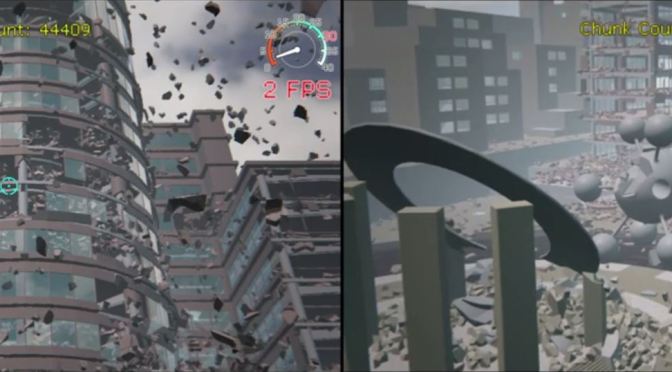During Microsoft’s Build 2014 conference, one of many interesting projects demoed was a prototype game using both local and server resources. Displayed onscreen was, the intricate dismantling of a multi-story building. When one glass pane was destroyed by the operator’s industrial laser weapon, it would shatter into hundreds of pieces. These chunks of concrete would then descend through gravity before shattering into hundreds of additional shards. The demo, later revealed to be a very early build of the next Crackdown title on Xbox One, was demonstrated primarily to showcase one way whereby the Xbox One might supersede its competition on the graphics front. The disparity in performance between the DDR3 memory of Microsoft’s console pitted against the GDDR5 memory in Sony’s PlayStation 4 has been covered in the games media ad nauseam. But having just wrapped up Build 2015, Microsoft has yet to release a title for its Xbox platform with the demoed tech.
Prototypes can sometimes be misleading. So skepticism regarding Microsoft’s claims is understandable. But in this case, the skepticism can be readily dismissed as the enmeshing of local and server resources for gaming purposes has already been accomplished. Titanfall, EA’s multiplayer-only game, delegated real-time enemy AI to an Azure server. NPC spawning, movements, and clean-up was computed “in the cloud” & then pushed to players in real-time. Most importantly, Titanfall executed well. The game performs as expected.
While AI & destructible environments are two different components in a game engine, they each share underlying code. Spatial positioning, placement, and movement are traits both components share. The offloading of these computational intensive tasks to a more powerful server, which then distributes the values for anyone connected to that particular game session, is again a distributable concept.
This technology was examined over a year ago and has yet to show up again in any publicly available games – alphas, betas, or otherwise. So where is it? Perhaps it is in HoloLand, a narrow place where $2 billion Minecraft and $4 billion Nokia acquisitions reside.
Source: Polygon
6/18/15 UPDATE: E3 2015 has just concluded and this graphics enhancing technology is still MIA.
8/04/15 UPDATE 2: Crackdown 3 was finally revealed at Gamescom 2015 with this tech in tow.

